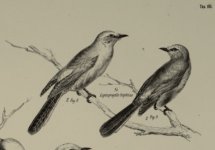Avis habitat in fluviis, inundatis, et lacubus vicinis flumini Cinu 30 leucis Carthagena Indica distanti. Incolis et Hispanis vocatur Chavaria. Corpus magnitudine galli gallinacei, a terra altum sesquipede. Collum longum. Cauda brevis. Caput et rostrum conicoincurvum, sordide albescens, maxilla superiore imbricata, sunt Gallinae similia. Crura corporis respectu crassissima et fortia. Genua omnium crasissima nodosaque. Tibiae longae, eoque visae longiores, quod plumis in summa parte tantum obteguntur, flavo-rubrae, etiam crassae. Pedes tetradactyli, digitis flavo-rubris, crassis, adeo longis, ut invicem quam maxime decussent semper, dum incedunt. Forte avis non datur, qui corporis respectu tam longos habet. Corpus, cauda et alae nigricant cum nebulis griseis; minus paulo nigricat venter. Collum atrum plumis veris nullis, sed lana curta densaque obtegitur totum. Simili lana, sed nivea, gaudent inferior pars capitis sub rostro et tempora ad latitudinem circiter pollicis unius. Ad basin rostri membrana implumis utrinque rubraque ad tempora extenditur, in cujus media parte sunt oculi iride fusca. Frons et occiput plumis ornantur veris corpori concoloribus at paulo minus fuscis. Occipitis infima pars in ipso loco, ubi cessat lana colli, ornatur crista ex duodecim circiter pennis tripollicaribus nigricantibus, respectu loci, unde oriuntur, perpendicularibus, corporis autem respectu decumbentibus. Nares oblongae, apertae, ut oculi utrinque lucem per illas conspicere valeant. Rostro vel unguibus nocere nequeunt. Dedit iis natura alia arma, quae aves rapaces valdopere timent. Calcaria utrinque in alis, ipsis ad illarum articulos duos, subtus gerunt ossea, nuda, durissima, crassa, acuta, semipollicaria, interdum utrinque tria, quae non apparent, nisi quando alas, quas longissimas fortissimasque habent, extendunt. Extensis his, quantum fieri potest, hostem aggrediuntur, et ictibus fortissimis trucidant. Incessus gravis, lentus et difficilis. Volatus facilis, et sat celer. Currere omnino non possunt, nisi simul semi-volent. Sylvestres gramine vescuntur et herbis. Asssuevi illas pani aqua macerato, et Zeae seminibus tusis diuque maceratis; aliud quid assumere noluerunt. Pedes aqua lavare amant. Quando tanguntur manu, cutis, sub plumis etiam lanosa, crepat fortiter ubique. Haec lana densa levitatem conciliat corpori, ita ut perfecte natent, hoc est aquis superemineant, et pedibus digitisque longissimis, qui alias non magis quam gallinarum natatori sunt, motis tamen in aquis progrediantur. Hac longitudine quoque accidit, ut in stagnis herbosis etiam profundis incedere possint. Indi, qui gallinas, anseres similesque aves enutriunt in magno numero, quas postea in foris vendant, in toto Carthagenensi territorio unam Chavariam possidere cicuratam curant. Haec tunc semper cum reliqua gallinarum turba per viciniam pergit. Nunquam has deserit, etsi volare possit, et domum ad vesperam revertitur. Ab homine adulto tunc tangi se patitur, et nemini nocet. Contra puerulos vero se defendit saepius. Aves rapaces ferre nequit et prima illas adoritur. Cum omnis ibidem regio plena sit vulturibus illis, Gallinazo dictis, vid. litteras meas primas de avibus. Illi saepe gallinas auferunt. Has defendunt Chavariae, et simulac vulturem talem appropinquantem conspiciunt (magis enim illi vultures solent ambulare quam volare), ilico occurrunt ipsi, qui raro adventum exspectat suum. Vox clara, alta, sed ingrata. Est avis certe pulcherrima, et habitu ab omnibus a me cognitis diversissima. Collum, caput et pedes adspectu singularia sunt. Novum genus mihi postulare videtur. Tu utere hac descriptione, quam in America ad ipsam avium concinnavi Gallice, hic traducta ad usum tuum. Emi alias pro duobus aureis, alias pro quibusdam obolis, nempe ex arbitrio Indi possidentis. In itinere reduci mare paucas hebdomadas sustinuerunt, puto, longitudine pedum maris motui non resistentes, sed continuis quassatae ictibus: ab 1. Novembris enim ad 26 februarii in mari fui, hyeme et tempestatibus continuis actus. Unde perierunt in itinere omnes.







